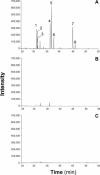Synthesis of novel lipids in Saccharomyces cerevisiae by heterologous expression of an unspecific bacterial acyltransferase
- PMID: 15574908
- PMCID: PMC535189
- DOI: 10.1128/AEM.70.12.7119-7125.2004
Synthesis of novel lipids in Saccharomyces cerevisiae by heterologous expression of an unspecific bacterial acyltransferase
Abstract
The bifunctional wax ester synthase/acyl-coenzyme A:diacylglycerol acyltransferase (WS/DGAT) is the key enzyme in storage lipid accumulation in the gram-negative bacterium Acinetobacter calcoaceticus ADP1, mediating wax ester, and to a lesser extent, triacylglycerol (TAG) biosynthesis. Saccharomyces cerevisiae accumulates TAGs and steryl esters as storage lipids. Four genes encoding a DGAT (Dga1p), a phospholipid:diacylglycerol acyltransferase (Lro1p) and two acyl-coenzyme A:sterol acyltransferases (ASATs) (Are1p and Are2p) are involved in the final esterification steps in TAG and steryl ester biosynthesis in this yeast. In the quadruple mutant strain S. cerevisiae H1246, the disruption of DGA1, LRO1, ARE1, and ARE2 leads to an inability to synthesize storage lipids. Heterologous expression of WS/DGAT from A. calcoaceticus ADP1 in S. cerevisiae H1246 restored TAG but not steryl ester biosynthesis, although high levels of ASAT activity could be demonstrated for WS/DGAT expressed in Escherichia coli XL1-Blue in radiometric in vitro assays with cholesterol and ergosterol as substrates. In addition to TAG synthesis, heterologous expression of WS/DGAT in S. cerevisiae H1246 resulted also in the accumulation of fatty acid ethyl esters as well as fatty acid isoamyl esters. In vitro studies confirmed that WS/DGAT is capable of utilizing a broad range of alcohols as substrates comprising long-chain fatty alcohols like hexadecanol as well as short-chain alcohols like ethanol or isoamyl alcohol. This study demonstrated the highly unspecific acyltransferase activity of WS/DGAT from A. calcoaceticus ADP1, indicating the broad biocatalytic potential of this enzyme for biotechnological production of a large variety of lipids in vivo in prokaryotic as well as eukaryotic expression hosts.
Figures



Similar articles
-
A novel bifunctional wax ester synthase/acyl-CoA:diacylglycerol acyltransferase mediates wax ester and triacylglycerol biosynthesis in Acinetobacter calcoaceticus ADP1.J Biol Chem. 2003 Mar 7;278(10):8075-82. doi: 10.1074/jbc.M210533200. Epub 2002 Dec 26. J Biol Chem. 2003. PMID: 12502715
-
Thio wax ester biosynthesis utilizing the unspecific bifunctional wax ester synthase/acyl coenzyme A:diacylglycerol acyltransferase of Acinetobacter sp. strain ADP1.Appl Environ Microbiol. 2005 Feb;71(2):790-6. doi: 10.1128/AEM.71.2.790-796.2005. Appl Environ Microbiol. 2005. PMID: 15691932 Free PMC article.
-
The wax ester synthase/acyl coenzyme A:diacylglycerol acyltransferase from Acinetobacter sp. strain ADP1: characterization of a novel type of acyltransferase.J Bacteriol. 2005 Feb;187(4):1369-76. doi: 10.1128/JB.187.4.1369-1376.2005. J Bacteriol. 2005. PMID: 15687201 Free PMC article.
-
Formation and mobilization of neutral lipids in the yeast Saccharomyces cerevisiae.Biochem Soc Trans. 2005 Nov;33(Pt 5):1174-7. doi: 10.1042/BST20051174. Biochem Soc Trans. 2005. PMID: 16246075 Review.
-
Key enzymes for biosynthesis of neutral lipid storage compounds in prokaryotes: properties, function and occurrence of wax ester synthases/acyl-CoA: diacylglycerol acyltransferases.Biochimie. 2007 Feb;89(2):230-42. doi: 10.1016/j.biochi.2006.07.013. Epub 2006 Aug 7. Biochimie. 2007. PMID: 16938377 Review.
Cited by
-
Transporter engineering for improved tolerance against alkane biofuels in Saccharomyces cerevisiae.Biotechnol Biofuels. 2013 Feb 13;6(1):21. doi: 10.1186/1754-6834-6-21. Biotechnol Biofuels. 2013. PMID: 23402697 Free PMC article.
-
Fatty acyl-CoA reductase and wax synthase from Euglena gracilis in the biosynthesis of medium-chain wax esters.Lipids. 2010 Mar;45(3):263-73. doi: 10.1007/s11745-010-3395-2. Epub 2010 Mar 2. Lipids. 2010. PMID: 20195781
-
Altered lipid composition and enhanced nutritional value of Arabidopsis leaves following introduction of an algal diacylglycerol acyltransferase 2.Plant Cell. 2013 Feb;25(2):677-93. doi: 10.1105/tpc.112.104752. Epub 2013 Feb 15. Plant Cell. 2013. PMID: 23417035 Free PMC article.
-
Wax Ester Synthase/Diacylglycerol Acyltransferase Isoenzymes Play a Pivotal Role in Wax Ester Biosynthesis in Euglena gracilis.Sci Rep. 2017 Oct 18;7(1):13504. doi: 10.1038/s41598-017-14077-6. Sci Rep. 2017. PMID: 29044218 Free PMC article.
-
In vitro reconstitution guide for targeted synthetic metabolism of chemicals, nutraceuticals and drug precursors.Synth Syst Biotechnol. 2016 Apr 1;1(1):25-33. doi: 10.1016/j.synbio.2016.02.003. eCollection 2016 Mar. Synth Syst Biotechnol. 2016. PMID: 29062924 Free PMC article. Review.
References
-
- Alvarez, H. M., R. Kalscheuer, and A. Steinbüchel. 1997. Accumulation of storage lipids in species of Rhodococcus and Nocardia and effects of inhibitors and polyethylene glycol. Fett/Lipid 99:239-246.
-
- Alvarez, H. M., and A. Steinbüchel. 2002. Triacylglycerols in prokaryotic microorganisms. Appl. Microbiol. Biotechnol. 60:367-376. - PubMed
-
- Arthington-Skaggs, B. A., D. N. Crowell, H. Yang, S. L. Sturley, and M. Bard. 1996. Positive and negative regulation of a sterol biosynthetic gene (ERG3) in the post-squalene portion of the yeast ergosterol pathway. FEBS Lett. 392:161-165. - PubMed
-
- Bullock, W. O., J. M. Fernandez, and J. M. Stuart. 1987. XL1-Blue: a high efficiency plasmid transforming recA Escherichia coli strain with β-galactosidase selection. BioTechniques 5:376-379.
MeSH terms
Substances
LinkOut - more resources
Full Text Sources
Other Literature Sources
Molecular Biology Databases

